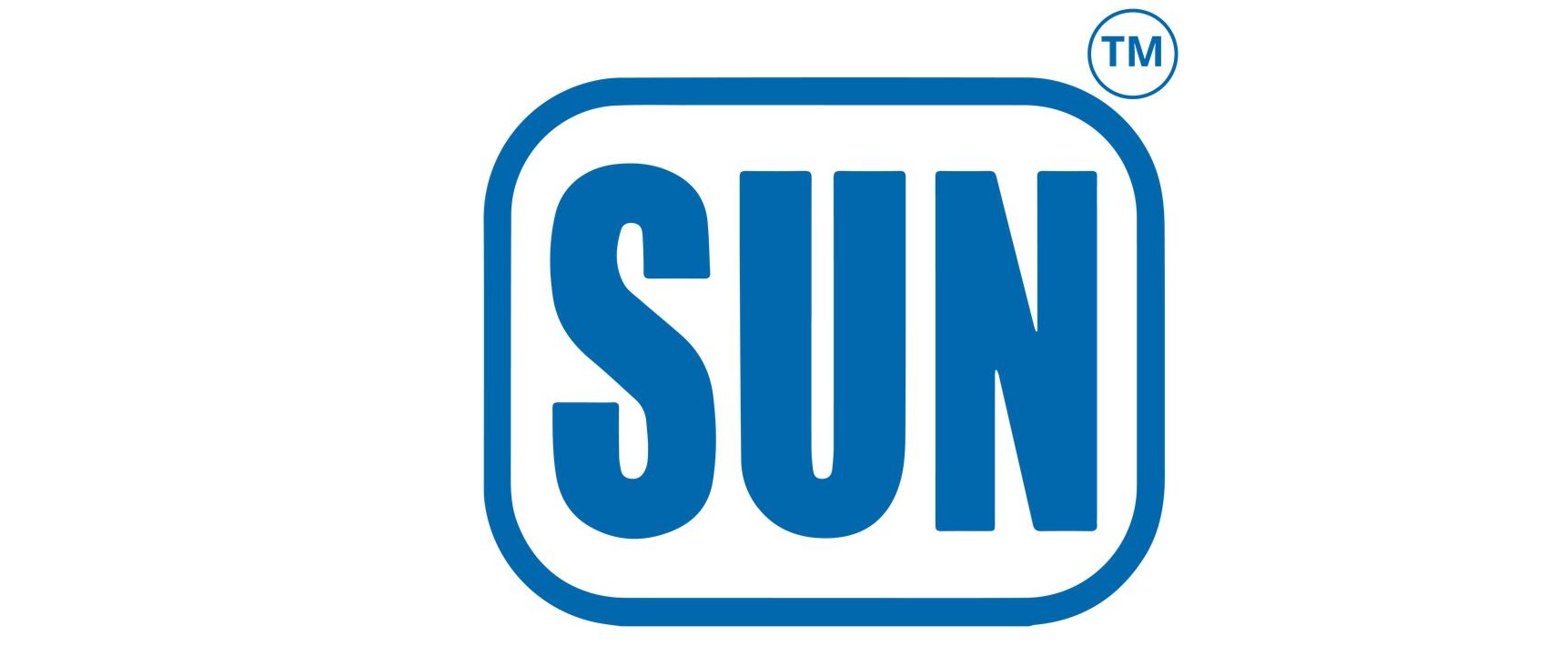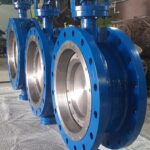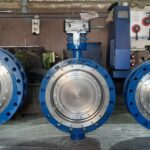Double Flange Type Double Eccentric Design Butterfly Valve
SUN’s Double Flange Type Double Eccentric Butterfly Valve is a type of valve used to control the flow of liquids or gases in pipes. It has two main features:
Double Flange: This means the valve has flanges on both ends, allowing it to be securely connected to pipes. The flanges make it easy to install and ensure a tight, leak-proof fit.
Double Eccentric Design: This refers to how the valve’s parts are designed. The shaft (the part that the valve’s disc rotates on) is slightly off-center from the valve’s body, and the disc itself is also positioned off-center from the shaft. This “double offset” design makes the valve open and close smoothly without much friction, reducing wear and tear.
Water Treatment:
Commonly used in potable water and wastewater pipelines.
HVAC:
For air flow control and fluid regulation in heating and cooling systems.
Chemical Processing:
For handling corrosive and aggressive chemicals.
Mining and Industrial Applications:
Often found in systems handling slurries or abrasive fluids.
Compact Design:
The wafer-type design reduces the weight and space required for installation, making it ideal for constrained spaces.
Ease of Installation:
These valves can be quickly and easily bolted between flanges, requiring fewer bolts than other valve types.
Cost-Effective:
Wafer-type valves generally have a lower cost due to their design, making them a budget-friendly solution.
Maintenance:
The split-body design makes the valve easier to maintain, with simplified access to internal components.
Versatility:
They are used in a variety of industries, from water treatment to HVAC systems.
| Specification | Details |
|---|---|
| Valve Type | Double Flange Type, Double Eccentric Design |
| Nominal Diameter (DN) | DN 50 to DN 2000 (2 inches to 80 inches) |
| Pressure Rating | PN 10, PN 16, PN 25, PN 40 (or ANSI Class 150, 300, 600, etc.) depending on application |
| End Connections | Flanged ends (DIN, ANSI, JIS, etc.) |
| Body Material | Cast Iron, Ductile Iron, Carbon Steel, Stainless Steel (304, 316), Alloy Steel, etc. |
| Seat Material | EPDM, NBR, PTFE, Viton, Metal, or other depending on fluid type |
| Disc Material | Stainless Steel, Cast Iron, Ductile Iron, Carbon Steel |
| Seal Type | Soft Seat (EPDM, NBR, etc.) or Metal Seat for high-temperature and pressure applications |
| Temperature Range | -20°C to 300°C (-4°F to 572°F), depending on materials and application |
| Flow Direction | Bi-directional flow |
| Operating Pressure | 10 bar, 16 bar, 25 bar, 40 bar (dependent on valve size and material) |
| Leakage Rate | Class VI (ANSI/FCI 70-2), Zero leakage for metal seated versions |
| Actuation Type | Manual, Pneumatic, Electric, Hydraulic |
| Stem Material | Stainless Steel, Carbon Steel |
| Temperature Control | Adjustable depending on actuator and seat material for high temperature applications |
| Torque Requirement | Varies based on size and pressure rating; typically low torque due to eccentric design |
| Face-to-Face Dimensions | ANSI B16.10, DIN 3202, or customized to fit pipeline standards |
| Testing Standards | ANSI/FCI 70-2 (for leakage), EN 12266, API 598, ISO 5208 |
| Certifications | ISO 9001, CE Marking, API, PED, TA Luft (for fugitive emissions) |
| Flow Characteristics | Linear flow characteristics; enhanced sealing in both open and closed positions |
| Weight | Varies by size, material, and pressure rating (e.g., for DN 100, around 15–25 kg) |
| Application | Water treatment, oil & gas, power plants, chemical industries, HVAC systems, etc. |
| Approval Standards | CE, UL, API, or as per specific industry requirements |
Notes:
- End Connections: Flanged ends could be designed to standard flange sizes like ANSI, DIN, or JIS depending on regional or application requirements.
- Seat Materials: The choice of material will depend on factors such as pressure, temperature, and the type of fluid being transported.
- Leakage Rate: Soft seated valves generally offer a higher level of sealing compared to metal seated valves, which are designed for high-temperature or high-pressure applications.
- Torque: Because of the double eccentric design, the required torque to operate the valve is significantly reduced compared to a single eccentric or zero eccentric butterfly valve.
- Face-to-Face Dimensions: The dimensions are typically standardized but can vary based on the specific valve model.
A wafer-type butterfly valve is distinguished by its body design, which does not have flanges. Instead, the valve is sandwiched between two flanges in the piping system. This design simplifies installation and reduces the space required for the valve.
Split-Body Construction:
The split-body design allows the valve body to be separated into two parts, facilitating easier maintenance and repair. This design enhances the durability and the sealing ability of the valve, especially in high-pressure systems.
Butterfly Valve Mechanism:
The valve features a rotating disc (resembling a butterfly), which controls the flow of fluid by rotating around its axis. In the open position, the disc aligns with the flow path, allowing fluid to pass. When the valve closes, the disc rotates 90 degrees to obstruct the flow.



